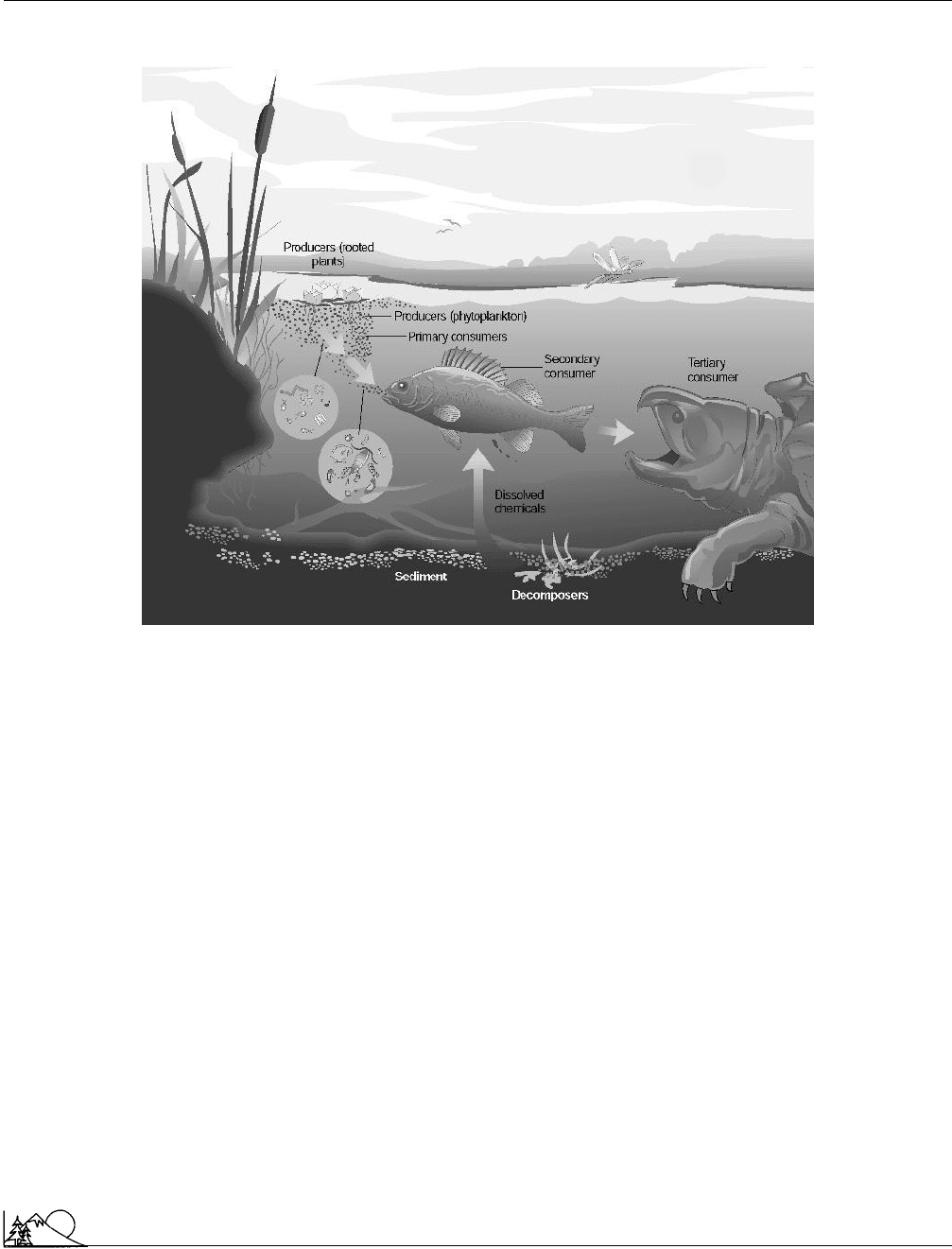Environmental Encyclopedia
Подождите немного. Документ загружается.


Environmental Encyclopedia 3
Mariculture
Smith, R. E. Ecology and Field Biology. 4th ed. New York: Harper &
Row, 1990.
P
ERIODICALS
Lugo, A. E., and S. C. Snedaker. “The Ecology of Mangroves.” Annual
Review of Ecology and Systematics 5 (1974): 39–64.
Ru
¨
tzler, K., and C. Feller. “Mangrove Swamp Communities.” Oceanus 30
(1988): 16–24.
Manure
see
Animal waste
Manville Corporation
see
Asbestos
Marasmus
A severe deficiency of all nutrients, categorized along with
other protein energy malnutrition disorders. Marasmus,
which means “to waste” can occur at any age but is most
commonly found in neonates (children under one year old).
Starvation resulting from marasmus is a result of protein
and carbohydrate deficiencies. In developing countries and
impoverished populations, early weaning from breast feeding
and over dilution of commercial formulas places neonates
at high risk for getting marasmus.
Because of the deficiency in intake of all dietary nutri-
ents, metabolic processes--especially liver functions--are
preserved, while growth is severely retarded. Caloric intake
is too low to support metabolic activity such as protein
synthesis or storage of fat. If the condition is prolonged,
muscle tissue wasting will result. Fat wasting and
anemia
are
common and severe. Severe vitamin A deficiency commonly
results in blindness, although if caught early, this process
can be reversed. Death will occur in 40% of children left
untreated.
Mariculture
Mariculture is the cultivation and harvest of marine
flora
and
fauna
in a controlled saltwater
environment
. Sometimes
called marine fish farming, marine
aquaculture
, or aquatic
farming, mariculture involves some degree of human inter-
vention to enhance the quality and/or quantity of a marine
harvest. This may be achieved by feeding practices, protec-
tion from predators, breeding programs, or other means.
Fish, crustaceans, salt-water plants, and shellfish may
be farm raised for bait, fishmeal and fish oil production,
scientific research,
biotechnology
development, and repop-
ulating threatened or
endangered species
. Ornamental
867
fish are also sometimes raised by fish farms for commercial
sales. The most widespread use of aquaculture, however, is
the production of marine life for human food consumption.
With seafood consumption steadily rising and
overfishing
of the seas a growing global problem, mariculture has been
hailed as a low-cost, high-yield source of animal-derived
protein.
According to the Fisheries Department of the United
Nations’ Food and Agriculture Organization (FAO), over
33 million metric tons of fish and shellfish encompassing
220 different
species
are cultured (or farmed) worldwide,
representing an estimated $49 billion in 1999. Pound for
pound, China leads the world in aquaculture production
with 32.5% of world output. In comparison, the United
States is only responsible for 4.4% of global aquaculture
output by weight. Just 7% of the total U.S. aquatic produc-
tion (both farmed and captured resources) is attributable
to aquaculture (compared to 62% of China’s total aquatic
output).
In the United States, Atlantic
salmon
and channel
catfish represent the largest segments of aquaculture produc-
tion (34% and 40%, respectively, in 1997). Though most
farmed seafood is consumed domestically, the United States
imports over half of its total edible seafood annually, repre-
senting a $7 billion annual trade deficit in 2001. The Depart-
ment of Commerce launched an aquaculture expansion pro-
gram in 1999 with the goal of increasing domestic seafood
supply derived from aquaculture production to $5 billion
annually by the year 2025. According to the U.S. Joint
Subcommittee on Aquaculture, U.S. aquaculture interests
harvested 842 million pounds of product at an estimated
value of $987 million in 1999.
To encourage further growth of the U.S. aquaculture
industry, the National Aquaculture Act was passed in 1980
(with amendments in 1985 and 1996). The Act established
funding and mandated the development of a national aqua-
culture plan that would encourage “aquaculture activities
and programs in both the public and private sectors of the
economy; that will result in increased aquacultural produc-
tion, the coordination of domestic aquaculture efforts, the
conservation
and enhancement of aquatic resources, the
creation of new industries and job opportunities, and other
national benefits.”
In the United States, aquaculture is regulated by the
U.S. Department of Agriculture
(USDA) and the Depart-
ment of Commerce through the National Marine Fisheries
Service (NMFS),
National Oceanic and Atmospheric Ad-
ministration
(NOAA). State and local authorities may also
have some input into the location and practices of maricul-
ture facilities if they are located within an area governed by
a Coastal Zone Management Plan (CZMP). Coastal Zone
Management Plans, as authorized by the
Coastal Zone

Environmental Encyclopedia 3
Mariculture
Management Act
(CZMA) of 1972, allow individual states
to determine the appropriate use and development of their
respective coastal zones. Subsequent amendments to the
CZMA have also made provision for states to be eligible
for federal funding for the creation of state plans, procedures,
and regulations for mariculture activities in the coastal zone.
Tilapia, catfish, striped bass, yellow perch, walleye,
salmon, and trout are just a few of the fresh and salt-water
finned fish species farmed in the United States. Crawfish,
shrimp, and shellfish are also cultured in the U.S. Some
shellfish, such as oysters, mussels, and clams, are “planted”
as juveniles and farmed to maturity, when they are harvested
and sold. Shellfish farmers buy the juvenile shellfish (known
as “spat") from shellfish hatcheries and nurseries. Oysters
and mussels are attached to lines or nets and put in a con-
trolled ocean environment, while clams are buried in the
beach or in sandy substrate below low tide. All three of these
shellfish species feed on
plankton
from salt water.
But just as overfarming takes a toll on terrestrial
natu-
ral resources
, aquaculture without appropriate environ-
mental management can damage native ecosystems. Farmed
fish are raised in open-flow pens and nets. Because large
populations of farmed fish are often raised in confined areas,
disease spreads easily and rapidly among them. And farmed
fish often transmit sea lice and other
parasites
and diseases
to wild fish, wiping out or crippling native stock. Organic
pollution
from
effluent
, the waste products from farmed
fish, can build up and suffocate marine life on the sea floor
below farming pens. This waste includes fish feces, which
contributes to
nutrient loading
, and
chemicals
and drugs
used to keep the fish disease free and promote growth. It
also contains excess fish food, which often contains dyes to
make farmed fish flesh more aesthetically analogous to its
wild counterparts.
Farmed fish that escape from their pens interbreed
with wild fish and weaken the genetic line of the native
stock. If escaped fish are diseased, they can trigger outbreaks
among indigenous marine life. Infectious Salmon
Anemia
,
a viral disease that has plagued fish farms in New Brunswick
and Scotland in the 1990s, was eventually found in native
salmon. In 2001, the disease first appeared at U.S. Atlantic
salmon farms off the coast of Maine.
The use of drugs in farmed fish and shellfish intended
for human consumption is regulated by the U.S.
Food and
Drug Administration
(FDA). In recent years,
antibiotic
resistance
has been a growing issue in aquaculture, as fish
have been treated with a wide array of human and veterinary
antibiotic drugs to prevent disease.
The commercial development of genetically-engi-
neered, or transgenic, farmed fish is also regulated by FDA.
As of May 2002, no transgenic fish had been cleared by
FDA for human consumption. The impact transgenic fish
868
may have on the survival and reproduction of native species
will have to be closely followed if and when commercial
farming begins.
As mandated by the 1938 Mitchell Act, the NMFS
funds 25 salmon hatcheries in the Columbia River Basin of
the Pacific Northwest, the largest federal marine fishery
program in the United States. These aquaculture facilities
were originally introduced to assist in repopulation of salmon
stocks that had been lost to or severely hampered by hydro-
electric dam projects. However, some environmentalists
charge that the salmon hatcheries may actually be endanger-
ing wild salmon further, by competing for local
habitat
and
weakening the genetic line of native species.
Without careful resource management, aquaculture
may eventually take an irreversible toll on other non-farmed
marine species. Small pelagic fish, such as herring, anchovy,
and chub, are captured and processed into fish food com-
pounds for high-density carnivorous fish farms. According
to the FAO, at its current rate, fish farming is consuming
twice as many wild fish in feeding their domestic counter-
parts as aquaculture is producing in fish harvests—an average
of 1.9 kg of wild fish required for every kilogram of fish
farmed.
No matter how economically sound mariculture has
been, it has also led to serious habitat modification and
destruction, especially in mangrove forests. In the past
twenty years, the area of mangrove forests have dwindled
by 35% worldwide. Though some of that loss is due to active
herbicide
control of mangroves, their conversion to salt
flats, and the industrial harvesting of forest products (wood
chips and lumber), mariculture is responsible for 52% of the
world’s mangrove losses.
Mangrove forests are important to the environment
because these ecosystems are
buffer
zones between saltwater
areas and freshwater/land areas. Mangroves act as
filters
for
agricultural nutrients and pollutants,
trapping
these con-
taminants before they reach the deeper waters of the ocean.
They also prevent coastal
erosion
, provide spawning and
nursery areas for fish and shellfish, host a variety of migratory
wildlife
(birds, fish, and mammals), and support habitats
for a number of endangered species.
Shrimp farming, in particular, has played a major role
in mangrove forest reduction. Increasing from 3% to 30% in
less than 15 years, commercial shrimp farming has impacted
coastal mangroves profoundly by cutting down mangrove
trees to create shrimp and prawn ponds. In the Philippines,
50% of the mangrove environments were converted to ponds
and between 50% and 80% of those in Southeast Asia were
lost to pond culture as well.
Shrimp mariculture places high demands on resources.
It requires large supplies of juvenile shrimp, which can seri-
ously deplete natural shrimp stocks, and large quantities of

Environmental Encyclopedia 3
Marine ecology and biodiversity
shrimp meal to feed them. There also is considerable waste
derived from shrimp production. This can pump organic
matter and nutrients into the ponds, causing eutrophication,
which causes algae bloom and oxygen depletion in the ponds
themselves or even downstream. Many shrimp farmers need
to pump pesticides, fungicides, parasiticides, and algicides
into the ponds between harvests to sterilize them and miti-
gate the effects of nutrient loading. Shrimp ponds also have
extremely short life spans, usually about 5–10 years, forcing
their abandonment and the cutting of more mangrove forests
to create new ponds.
Mariculture also limits other marine activities along
coastal waters. Some aquaculture facilities can occupy large
expanses of ocean along beaches which become commercial
and recreational no-fish zones. These nursery areas are also
sensitive to disturbances by recreational activities like boating
or swimming and the introduction of pathogens by domestic
or farm animals.
[Paula Anne Ford-Martin]
R
ESOURCES
B
OOKS
Food and Agriculture Organization of the United Nations. The State of
World Fisheries and Aquaculture Rome, Italy: FAO, 2000. [cited June 5,
2002]. <http://www.fao.org/DOCREP/003/X8002E/X8002E00.htm>.
Jahncke, Michael L. et al.Public, Animal, and Environmental Aquaculture
Health Issues. New York: John Wiley & Sons, 2002.
Olin, Paul. “Current Status of Aquaculture in North America.” From
Aquaculture in the Third Millennium: Technical Proceedings of the Conference
on Aquaculture in the Third Millennium, Bangkok, Thailand. 20-25 February
2000.Rome, Italy: FAO, 2000.
P
ERIODICALS
Barcott, Bruce, and Natalie Fobes. “Aquaculture’s Troubled Harvest.”
Mother Jones 26, no.6 (November –December 2001): 38 (8).
Naylor, Rosamond, et al. “Effect of Aquaculture on World Fish Supplies.”-
Nature(June 29, 2000).
O
THER
“National Aquaculture Policy, Planning, and Development.” 16 USC 2801.
[cited June 4, 2002]. <http://www.access.gpo.gov/uscode/title16/
chapter48_.html>.
National Marine Fisheries Service, National Oceanic and Atmospheric
Administration. Aquaculture. [cited July 2002]. <http://www.nmfs.noaa.-
gov/aquaculture.htm>.
O
RGANIZATIONS
The Northeast Regional Aquaculture Center, University of Massachusetts
Dartmouth, Violette Building, Room 201 285 Old Westport Road,
Dartmouth, MA USA 02747-2300 (508) 999-8157, Fax: (508) 999-8590,
Toll Free: (866) 472-NRAC (6722), Email: nrac@umassd.edu, http://
www.umassd.edu/specialprograms/NRAC/
869
Marine ecology and biodiversity
Understanding the nature of ocean life and the patterns of
its diversity represents a difficult challenge. Not only are
there technical difficulties involved with studying life under
water (high pressure, need for oxygen tanks, lack of light),
there is an urgency to develop a greater understanding of
marine life as links between ocean processes and the larger
patterns of terrestrial life become more well known. Our
current understanding of oceanic life is based on three princi-
pal concepts: size, complexity, and spatial distribution.
Our knowledge about the size of the ocean’s domain is
grounded in three great discoveries of the past few centuries.
When Magellan first circumnavigated the earth he inadver-
tently found that the oceans were a continuous water body,
rather than a series of discrete bodies of water. Some time
later, the encompassing nature of the world oceans was fur-
ther clarified by the discovery that the oceans were a chemi-
cally uniform aqueous system. All of the principal ions (so-
dium, chloride, and sulfate) exist in the same concentrations.
The third discovery, still underway, is that the ocean is
composed of comparatively immense ecological systems.
Thus in most ways the oceans are a unified system which is
the first defining characteristic of the marine
environment
.
There is, however, a dichotomy between the integral
nature of the ocean and the external forces played upon it.
Mechanical, thermodynamic, chemical, and biological forces
create variation through such things as differential heating,
Coriolis force, wind, dissolved gases,
salinity
differences,
and evaporation. The actions in turn set controls in motion
which move toward physical equilibrium through feedback
mechanisms. Those physical changes then interact with bio-
logical systems in nonlinear ways, that is, out of synchroniza-
tion with the external stimuli and become quite difficult to
predict. Thus, we have the second broad characteristic of
the oceans, complexity.
The third major aspect of ocean life is that life itself
is sparse in terms of the overall volume of the oceans, but
locally productive systems can create immense populations
and/or sites with exceptionally high
species
diversity. Life
is arranged in active layers dictated by nutrients and light
in the horizontal planes, and by vertical current (downwelling
and upwelling) in the vertical planes. Life decreases through
the depth zones from the epipelagic zone in the initial 328
ft (100 m) of the water column to the bottom layers of water,
and then jumps again at the benthic layer at the water-
substrate interface. Life also decreases from the littoral zones
along the world’s shorelines to the open ocean, interrupted
by certain areas with special life supporting systems, like
floating sargasso weed beds.
In the past twenty years the focus of
conservation
has shifted to include not only individual species or habitats,

Environmental Encyclopedia 3
Marine Mammals Protection Act (1972)
but to a phenomenon called biological diversity, or
biodiver-
sity
for short. Biological diversity encompasses from three
to four levels. Genetic diversity is the level of genotypic
differences within all the individuals that constitute a popula-
tion of organisms; species diversity refers to the number of
species in an area; and community diversity to the number
of different community types in a landscape. The highest
level, landscape diversity has not frequently been applied in
aqueous environments and will not be discussed here.
Commonly, species diversity is interpreted as biologi-
cal diversity, and since few marine groups, except marine
mammals, have had very much genetic work done, and com-
munity functions are only well known from a few systems,
it is the taxonomic interpretation of diversity that is most
commonly discussed (e.g., species or higher taxonomic levels
such as families and classes, orders and phyla). Of all the
species that we know, roughly 16% are from the seas. General
diversity patterns in the sea are similar to those on land,
there are more smaller than larger species, and there are
more tropical species than temperate or polar species. There
are centers of diversity for specific taxa, and the structure of
communities and ecosystems is based on particular patterns
of energy availability. For example,
estuary
systems are
productive due to importation of
nitrogen
from the land,
coral reefs are also productive, but use scarce nutrients effi-
ciently by specially adapted filter feeding mechanisms. Abys-
sal communities, on the other hand, depend on their entire
energy supply from
detritus
fall from upper levels in the
ocean. Perhaps the most specifically adapted of all life forms
are the hydrothermal vent communities that employ
chemo-
synthesis
rather than
photosynthesis
for primary produc-
tion. Water temperature, salinity, and pressure create dif-
fering ecosystems in ways that are distinctly different from
terrestrial systems. In addition, the boundaries between sys-
tems may be dynamic, and are certainly more difficult to
detect than on land.
Most marine biodiversity occurs at higher taxonomic
levels, while the land holds more species, most of them are
arthropods. Most of the phyla (32 of 33) that we now know
are either marine, or both marine and non-marine, while
only one is exclusively non-marine. Thus most of the major
life plans exist in the sea.
We are now learning that the number of species in
the ocean is probably underestimated as we discover more
cryptic species, very similar organisms that are actually dis-
tinct, many of which have been discovered on the deep ocean
floor. This is one of the important diversity issues in the
marine environment. Originally, the depths were cast as
biological deserts, however, that view may have been pro-
moted by a lack of samples, the small size of many benthic
invertebrates, and the low density of benthic populations in
the deep sea beds.
870
Improved sampling since the 1960s changed that view
to one of the ocean floor as a highly species diverse environ-
ment. The deep sea is characterized by a few individuals in
each of many species; rarity dominates. Whereas, in shallow
water benthic environments, there are large, dense popula-
tions dominated by a few species. At least three theoretical
explanations for this pattern have been made. The stability-
time hypothesis suggests that ocean bottoms have been very
stable environments over long periods of time. This condi-
tion causes very finely tuned adaptations to narrow niches,
and results in many closely related species. The disturbance
or “cropper” hypothesis suggests that intense predation of
limited food sources prevents populations from reaching
high levels and because the food source is dominated by
detrital rain, generalist feeders abound and compete for the
same food, which results in only small differences between
species. A third hypothesis is that the area of the deep sea
bed is so large it supports many species, following from
generalizations made by the species area relationship concept
used in
island biogeography
theory. The picture of species
number and relative rarity is still not clearly understood.
In general, some aspects of marine biology are well
studied. Rocky intertidal life has been the subject of major
ecological research and yielded important theoretical ad-
vances. Similarly, coral reefs are the subject of many studies
of life history
adaptation
and evolutionary biology and
ecology
. Physiology and morphology research has used
many marine animals as examples of organisms’ functions
under extreme conditions. This new found knowledge is
timely. Up until now we have considered the oceans as an
inexhaustible source of food and a sink for our wastes, yet
we now realize they are neither. Relative to the land, the
sea is in good ecological condition, but to prevent major
ecological problems in the marine environment we need to
increase human knowledge rapidly and manage our behavior
toward the oceans very conservatively, which is a difficult
task under the conditions where the ocean is treated as a
common resource.
[David Duffus]
Marine Mammals Protection Act
(1972)
The Marine Mammals Protection Act (MMPA) was ini-
tially passed by Congress in 1972 and is the most compre-
hensive federal law aimed at the protection of marine mam-
mals. The MMPA prohibits the taking (i.e., harassing,
hunting
, capturing, or killing, or attempting to harass, hunt,
capture, or kill) on the high seas of any marine mammal by
persons or vessels subject to the jurisdiction of the United
States. It also prohibits the taking of marine mammals in

Environmental Encyclopedia 3
Marine Mammals Protection Act (1972)
An example of a marine ecosystem. (Illustration by Hans & Cassidy.)
waters or on land subject to United States jurisdiction and
the importation into the United States of marine mammals,
parts thereof, or products made from such animals. The
MMPA provides that civil and criminal penalties apply to
illegal
takings
.
The MMPA specifically charges the National Marine
Fisheries Service (NMFS) with responsibility for the protec-
tion and
conservation
of marine mammals. The NMFS is
given statutory authority to grant or deny permits to take
whales
,
dolphins
, and other mammals from the oceans.
The original legislation established “a moratorium on
the taking of marine mammals and marine mammal prod-
ucts...during which time no permit may be issued for the
taking of any marine mammal and no marine mammal may
be imported into the United States.” Four types of exceptions
allowed for limited numbers of marine mammals to be taken:
(1) animals taken for scientific review and public display,
after a specified review process; (2) marine mammals taken
incidentally to
commercial fishing
operations prior to Oc-
tober 21, 1974; (3) animals taken by Native Americans and
Inuit Eskimos for subsistence or for the production of tradi-
tional crafts or tools; and (4) animals taken under a temporary
871
exemption granted to persons who could demonstrate eco-
nomic hardship as a result of MMPA (this exemption was
to last for no more than a year and was to be eliminated in
1974). MMPA also sought specifically to reduce the number
of marine mammals killed in purse-seine or drift net opera-
tions by the commercial tuna industry.
The language used in the legislation is particularly
notable in that it makes clear that the MMPA is intended to
protect marine mammals and their supporting
ecosystem
,
rather than to maintain or increase commercial harvests:
“[T]he primary objective in management should be to main-
tain the health and
stability
of the marine ecosystem.
Whenever consistent with this primary objective, it should
be the goal to obtain an optimum sustainable population
keeping in mind the optimum
carrying capacity
of the
habitat.”
All regulations governing the taking of marine mam-
mals must take these considerations into account. Permits
require a full public hearing process with the opportunity
for judicial review for both the applicant and any person
opposed to the permit. No permits may be issued for the
taking or importation of a pregnant or nursing female, for

Environmental Encyclopedia 3
Marine pollution
taking in an inhumane manner, or for taking animals on
the
endangered species
list.
Subsidiary legislation and several court decisions have
modified, upheld, and extended the original MMPA: Globe
Fur Dyeing Corporation v. United States upheld the constitu-
tionality of the statutory prohibition of the killing of marine
mammals less than eight months of age or while still nursing.
In Committee for Humane Legislation v. Richardson,
the District of Columbia Court of Appeals ruled that the
NMFS had violated MMPA by permitting tuna fishermen
to use the purse-seine or drift net method for catching yel-
lowfin tuna, which resulted in the drowning of hundreds of
thousands of porpoises.
Under the influence of the Reagan Administration,
MMPA was amended in 1981 specifically to allow this type
of fishing, provided that the fishermen employed “the best
marine mammal safety techniques and equipment that are
economically and technologically practicable.” The Secretar-
ies of Commerce and the Interior were empowered to autho-
rize the taking of small numbers of marine mammals, pro-
vided that the
species
or population stocks of the animals
involved were not already depleted and that either Secretary
found that the total of such taking would have a negligible
impact.
The 1984 reauthorization of MMPA continued the
tuna industry’s general permit to kill incidentally up to
20,500 porpoises per year, but provided special protection
for two threatened species. The new legislation also required
that yellowfin tuna could only be imported from countries
that have rules at least as protective of porpoises as those of
the United States.
In Jones v. Gordon (1985), a federal district court in
Alaska ruled in effect that the
National Environmental
Policy Act
provided regulations which were applicable to the
MMPA permitting procedure. Significantly, this decision
made an
environmental impact statement
mandatory
prior to the granting of a permit.
Presumably owing to the educational, organizing, and
lobbying efforts of environmental groups and the resulting
public outcry, the MMPA was amended in 1988 to provide
a three-year suspension of the “incidental take” permits,
so that more ecologically responsible standards could be
developed. Subsequently, Congress decided to prohibit the
drift netting method as of the 1990 season.
In 1994, the MMPA was amended to include more
concrete definitions of harassment levels and grouped them
as level A harassment (potential to hurt a wild marine mam-
mal) and level B harassment (potential to disrupt their
envi-
ronment
or biology). The 1994 amendments also con-
structed new restrictions of photography permits and states
872
under harassment level B that scientific research must limit
its influence on the marine mammals being studied.
[Lawrence J. Biskowski]
R
ESOURCES
B
OOKS
Dolgin, E. L., and T. G. P. Guilbert, eds. Federal Environmental Law.
St. Paul, MN: West Publishing Co., 1974.
Freedman, W. Federal Statutes on Environmental Protection. New York:
Quorum Books, 1987.
P
ERIODICALS
Hofman, J. “The Marine Mammals Protection Act: A First of Its Kind
Anywhere.” Oceanus 32 (Spring 1989): 7–16.
O
THER
National Marine Fisheries Services. [cited June 2002]. <http://
www.nmfs.noaa.gov>.
Marine pollution
Marine
pollution
is a major threat to any organism living
in or depending upon the ocean. Human impact on coastal
and open ocean habitats comes in many forms:
nutrient
loading
from agricultural
runoff
and sewage discharges,
toxic chemical inputs from industry and agriculture,
petro-
leum
spills, and inert solid wastes. While there has been
some recognition of the destruction of marine systems from
pollution, regulations are often weak or are not enforced.
Recent efforts have lead to slow recovery of some coastal
areas, but many of the detrimental practices continue and
some systems may never recover.
Nutrient loading is perhaps the most well-studied form
of pollution, and its biological consequences have been ob-
served and documented. Algal blooms, including red tides,
have been attributed to elevated nutrient levels in coastal
systems. These blooms, through their
respiration
and
de-
composition
, can deplete the levels of
dissolved oxygen
in the waters to almost zero, killing
zooplankton
, fish,
and shellfish. These nutrients often come from runoff of
agricultural fertilizers, the use of which has increased seven-
fold since 1950. It is estimated that approximately 25 percent
of the 46.8 million metric tons of
fertilizer
used in the
United States annually enters rivers and coastal waters.
Another source of nutrients is the
discharge
of sew-
age. The United States and England are the only countries
that dump
sludge
into the oceans, averaging 17 million
metric tons annually between them. Throughout the world,
however, raw sewage is released into rivers and coastal habi-
tats by many countries, leading to algal blooms and increased
biochemical oxygen demand
. BOD, the rate at which
oxygen disappears from a sample of water, increases dramati-

Environmental Encyclopedia 3
Marine pollution
cally with loading of organic material such as sewage, and
results in the lowering of dissolved oxygen levels. The wastes
of domesticated animals may also have a major impact in
some systems. A single cow produces approximately 31 lb
(14 kg) of waste per day, the equivalent of ten people. When
discharged into rivers or coastal waters, wastes produced by
large herds or
feedlots
may have substantial effects.
Boston Harbor is considered to be one of the most
polluted harbors in the United States. Since Europeans set-
tled in the Boston area, domestic wastes have been dis-
charged directly into the harbor. As Boston’s population
grew, so did the dumping, a problem exacerbated by the
growth of industry in the late nineteenth and early twentieth
centuries. Fish and shellfish in the harbor contain toxic
levels of polychlorinated biphenyl (PCB) and
heavy metals
,
BOD levels are astronomical, and dissolved oxygen levels
are low. In 1984, the Massachusetts
Water Resources
Au-
thority (MWRA) was formed and has managed to improve
water quality
of the harbor slightly. Recommendations of
the MWRA have been hard to enact, however.
Sewage
treatment
modifications have been met with
Environmen-
tal Protection Agency
(EPA) and State objections, shelving
the project while courts decide the fate of environmental
quality in Boston Harbor.
Toxic substances are introduced into the marine
envi-
ronment
from various sources, some of which may be hun-
dreds of kilometers away. Heavy metals, pesticides, and
acid
rain
threaten not only coastal and estuarine systems, but
also life in the open ocean. Heavy metals occur in many
forms, some of which are soluble in seawater. These soluble
compounds may not be the forms in which they were origi-
nally released into the environment, often making their
sources difficult to determine. Many heavy metals are re-
leased in industrial effluents, especially from chemical plants,
smelters, and mining runoff. These compounds may affect
humans directly through contact, or indirectly, from the
consumption of fish and shellfish, where metals often accu-
mulate in tissues.
Between the late 1930s and the mid-1950s, a Japanese
chemical company manufacturing acetaldehyde discharged
mercury
into Minamata Bay, where it formed a soluble
compound that accumulated in fish. It was not until 50
people died of
Minamata disease
and hundreds were left
with debilitating nervous disorders from eating poisoned fish
that environmental studies were initiated. Finally, in 1969,
the plant was closed. Other metals, such as zinc,
cadmium
,
copper
, and silver, are commonly discharged into marine
systems by industry. Not only are these metals toxic by
themselves, but synergistic effects compound their toxicity.
Acid
precipitation is rain, snow, or fog that has a lower
pH
than normal and is caused by inputs of nitric and sulfuric
acid into the
atmosphere
from manufacturing and the
873
burning of
fossil fuels
, as in automobiles. These causes may
be far from the area of impact since prevailing winds can
carry pollutants considerable distances. The ocean has a high
buffer
capacity, that is, the ability to neutralize many of the
acid inputs. Therefore, most of the severe effects of acid rain
are observed in freshwater lakes and rivers. Some estuaries,
however, may also be seriously impacted, as has been ob-
served in the upper
Chesapeake Bay
. The pH of a river
feeding the Bay dropped from 6.3 to 5.8 between 1972 and
1978. Juvenile and spawning striped bass may not be able
to tolerate such high acidity. Precipitation of nitrogen-based
acid also increases nutrient loading in aquatic systems.
Toxic organic compounds, especially pesticides and a
family of
chemicals
known as PCBs, have been shown to
have serious effects on marine systems. Runoff has intro-
duced considerable amounts of PCBs, DDT, and many other
synthetic organic compounds into coastal areas. These com-
pounds may persist for many years. In 1976, Congress
banned the manufacture of PCBs, but they are still found
today as coolants in older transformers and buried in sedi-
ments. It is estimated that 1 percent of PCBs used have
reached the ocean. In 1987–1988, 700 bottlenose
dolphins
washed up on the U.S. Atlantic coast and some were found
to have elevated levels of PCBs and DDE (a form of DDT).
Biologists claim that these compounds inhibited the dol-
phins’ immune systems, making them vulnerable to infec-
tions. In 1975, workers at a chemical plant on the Chesa-
peake were poisoned when the insecticide
Kepone
was
leaked or dumped into the bay. The Kepone spread down-
stream where it poisoned fish and shellfish.
One of the most publicized sources of marine pollution
is that caused by petroleum products. While large
oil spills
can devastate a local area, equally important is the discharge
of crude oil while cleaning bilges and emptying tanks at sea.
Over the past decade, an average of approximately 32 million
gallons (120 million l) of oil have been spilled annually. The
Gulf of Mexico has recorded the most spills, while spills in
the Persian Gulf average 2 million gallons (7 million l)
per year. Since tanker ports and refineries are, by necessity,
located on the coast, these sensitive areas receive considerable
damage from the spills. The damage to marine life is stag-
gering. Seabirds are killed by the hundreds of thousands
annually, their oil-matted plumage making flight impossible
and exposing them to hypothermia. Oil-soaked fur of marine
mammals loses its water repellency, also leading to death by
hypothermia. Ingestion of oil by fishes, birds, and mammals
also may result in death.
Hundreds of tons of inert solid wastes are dumped
into the oceans from ships annually. Of these,
plastics
and
polystyrene
(styrofoam) are deadly to marine life. Often
floating for hundreds of miles and lasting for many years,
plastics are frequently mistaken for food by fishes, turtles,

Environmental Encyclopedia 3
Marine protected areas
and mammals, and proceed to either interfere with subse-
quent feeding or strangle the consumer. It has been estimated
that plastics and discarded fishing gear, such as monofila-
ment line and discarded nets, kill one million seabirds and
150,000 marine mammals each year.
Beginning with the Refuse Act of 1899 and the
Water
Pollution
Act of 1948, there have been efforts to remedy
the polluted oceans. Not until 1972, however, was legislation
drafted that was powerful enough, and sufficient monies
appropriated, to effect any change. With the Federal Water
Pollution Act, or
Clean Water Act
, improvement of water
quality in the United States began. By 1985, five of the goals
of the 1972 Act were reached, and since then, the Clean
Water Act has been rewritten to reflect increasing national
concerns.
Pollution of the world’s oceans had become so
pervasive that an international convention was convened
in 1973 to establish laws governing the discharge of all
wastes into the ocean. The International Convention for
the Prevention of Pollution from Ships (1978), commonly
known as MARPOL, and subsequent annexes to the
convention, covers all
garbage
discharged by ships at sea
beyond three miles from shore. While it is too soon
to tell, adherence to the MARPOL agreement should
significantly reduce the amount of solid wastes polluting
the world’s oceans.
Boston Harbor, the Chesapeake Bay, and the
Medi-
terranean Sea
are the most publicized examples of marine
pollution. However, the problem is widespread. Many
estuaries in Southeast Asia, many coastal areas in Japan,
and the waters off Rio de Janeiro are also areas where
historical and current use of the waters as dumping grounds
has left them in disastrous conditions. The Golden Horn
estuary around Istanbul, Turkey, has been declared dead,
containing no living organisms and posing a threat to
surrounding waters at the eastern end of the Mediterranean.
Since humans have been living along the coasts and
using the seas as waste dumping grounds for thousands of
years, these areas are the most heavily impacted. What makes
matters worse is that coastal waters are vital spawning and
nursery grounds for most of the commercially harvested fish
and shellfish in marine systems. Destruction of these areas
has significant nutritional and economic repercussions. Ex-
amples of the world-wide destruction of marine habitats due
to pollution are numerous, but, with increased international
efforts to limit inputs and rehabilitate damaged areas, im-
provements in the health of marine systems may be seen.
See also Bioaccumulation; Estuary; Food chain/web; Heavy
metals and heavy metal poisoning
[William G. Ambrose Jr. and Paul E. Renaud]
874
R
ESOURCES
B
OOKS
Clark, R. B. Marine Pollution. New York: Oxford University Press, 1989.
Nybakken, J. W. Marine Biology: An Ecological Approach. 2nd ed. New
York: Harper and Row, 1988.
P
ERIODICALS
Dolin, E. J. “Boston’s Murky Political Waters.” Environment 34 (1992):
6–33.
Marine protected areas
Marine protected areas (MPAs)are marine environments
that enjoy certain federal, state, local, or tribal regulation
and
conservation
management programs by virtue of their
unique ecosystems and/or cultural resources.
Known variously as marine reserves, marine sanctuar-
ies, and/or no- take areas, marine protected areas may include
national marine sanctuaries, marine features of national parks
and monuments, marine
wildlife
refuges, fishery reserves,
estuarine reserves, or state conservation areas and reserves.
They may be regulated as no-take areas, meaning that marine
resources and/or marine life cannot be removed from these
sanctuaries. Or, they may allow fishing and other commercial
or recreational activities within certain guidelines and limita-
tions. Management of an MPA is determined on a site-by-
site basis by one or more federal, state, territorial, local, and/
or tribal regulatory authorities.
Marine protected areas are not just a reaction to the
effects of industrialization. They have existed in some form
among traditional fishing cultures for centuries. Tabu or
kapu areas, controlled by clans or chiefs in Oceania, created
no-take zones. When westernization occurred, many of these
areas disappeared. In recent years, some of these tabu areas
have been revived.
Some countries created protected areas along their
coastlines through governmental decrees or legislation. The
Royal
National Park
in New South Wales,
Australia
,is
perhaps the oldest protected area in the world. Designated
in 1879, the park prohibits the use of explosives, net-fishing,
and the commercial harvesting of oysters. Certain areas re-
strict all
commercial fishing
. Other Australian reserves fol-
lowed. Today, another Australian MPA, the
Great Barrier
Reef
Marine Park, is considered one of the most successful
multiple-use MPAs in the world.
Other governments soon instituted marine protected
areas on their shores. New Zealand has led the world with
the establishment of 291 MPAs. Africa has established 92
reserves, and Europe is rapidly catching up, with MPAs
popping up in France, Spain, Greece, Albania, Bosnia, and
Croatia.

Environmental Encyclopedia 3
Marine protected areas
Though the United States has 9,3208 mi.(150,000
km) of coastline and had some initial legislation in place, it
waited until serious damage was occurring before developing
a viable plan to coordinate the nation’s MPA-related initia-
tives. Unfortunately, much of the focus of the US MPAs
will first be on remediaton of many of its fragile coastal
environments before concentrating on developing an inclu-
sive plan for its extensive coastline.
In May 2000, President Clinton signed Executive Or-
der 13158 on Marine Protected Areas, which was designed
to ensure the long-term security of critical ocean habitats,
marine life, and cultural resources through an integrated
national network of science-based MPA selection and man-
agement. The order designated the Department of Interior
and Department of Commerce as jointly responsible for the
MPA mission to “(a) strengthen the management, protec-
tion, and conservation of existing marine protected areas and
establish new or expanded MPAs; (b) develop a scientifically
based, comprehensive national system of MPAs representing
diverse U.S. marine ecosystems, and the Nation’s natural
and cultural resources; and (c) avoid causing harm to MPAs
through federally conducted, approved, or funded activities.”
Executive Order 13158 mandated the creation of a
national database of MPAs. This register of nationally-rec-
ognized MPAs would promote integrated conservation ef-
forts between federal, state, and local authorities and stake-
holders. Order 13158 defined an MPA as “any area of the
marine
environment
that has been reserved by federal, state,
territorial, tribal or local laws or regulations to provide lasting
protection for part or all of the natural and cultural resources
therein.” To further hone this relatively broad-based defini-
tion, the
National Oceanic and Atmospheric Administra-
tion
(NOAA) has established five criteria for inclusion in
the MPA inventory:
O
The site must have defined geographical boundaries and
must be in federal, U.S. territorial, state, or tribal marine
areas.
O
The site must be marine in
nature
, meaning that it in-
cludes ocean or coastal waters, including intertidal areas,
bays, and estuaries. It may also be a part of the
Great
Lakes
or their connecting waters, and can include land as
an integral component of the site.
O
Must be established as a reserved area by Federal, state,
territorial, local, or tribal law or regulation.
O
Must be lasting, as in a permanent and year-round pro-
tected area.
O
Must have existing laws or regulations that are designed
and applied to afford the site with increased protection for
part or all of the natural and cultural resources therein.
The MPA list had not yet been developed as of May 2002.
875
The establishment of a MPA list or inventory would
bring further clarity and regulatory integration to a legacy
of environmental legislation affecting ocean habitats that
began with the National Marine Sanctuaries Act (NMSA)
in 1972 (and its amendments and reauthorizations in 1980,
1984, 1988, 1992, 1996, and 2000). NMSA, Title III of
the
Marine Protection, Research and Sanctuaries Act
,
was signed by President Nixon on the 100-year anniversary
of the
National Park Service
. The Act set up the criteria
for national sanctuaries that today only include 13 marine
areas spanning approximately 18,000 mi
2
(28,967.4 km
2
).
As of May 2002, U.S. nationally- designated sanctuaries
include:
O
Channel Islands. Designated as a marine sanctuary in 1980,
the Channel Islands are located off the coast of Santa
Barbara, California. The unique
ecosystem
of the sanctu-
ary is home to giant kelp forests and 27
species
of
whales
and dolphins.
O
Cordell Bank. Cordell Bank is a submerged island on the
edge of the continental shelf off the coast of San Francisco.
The sanctuary, created in 1989, covers 526 mi
2
(846.5 km
2
)
that are home to a rich and diverse array of marine life.
O
Fagatele Bay. A tropical
coral reef
formed by a now-extinct
volcano
, Fagatele Bay is located off of Tutuila, an island
of American Somoa. The sanctuary was designated in 1986.
O
Florida Keys. The Florida Keys National Marine Sanctuary
encompasses 28,000 nautical mi
2
(51,856 km
2
) surrounding
the Florida Keys, and includes such unique features as coral
reefs and mangroves. It was established in 1990.
O
Flower Garden Banks. A series of three sites off the coasts
of Texas and Louisiana, Flower Garden Banks was estab-
lished in 1992 and 1996 as a national marine sanctuary
(two sites in 1992 and the third in 1996). The area’s unique
coral reefs and twin salt domes host an abundance of tropi-
cal marine life.
O
Gerry E. Studds-Stellwagen Bank National Marine Sanctu-
ary. This nutrient-rich expanse of Massachusetts Bay is
home to the endangered right and humpback whales. It
was designated in 1992.
O
Gray’s Reef. Given sanctuary status in 1981 by President
Carter, Gray’s Reef is a sandstone reef with a “live-bottom
habitat"—attached corals, sponges, and other invertebrates.
The sanctuary encompasses 17 mi
2
(27.4 km
2
) off the coast
of Georgia.
O
Gulf of the Farallones. The 1,255 mi
2
(2,019.7 km
2
) Gulf
of the Farallones National Marine Sanctuary was created
in 1981. Located 30 mi. (48 km) west of San Francisco
Bay’s Golden Gate Bridge, the Farallones sanctuary is
home to a variety of
seals
,
sea lions
, and seabirds.
O
Hawaiian Islands Humpback Whale. An estimated two-
thirds of the entire Pacific humpback whale population

Environmental Encyclopedia 3
Marine Protection, Research and Sanctuaries Act (1972)
return to the
Hawaiian Islands
in the winter to breed,
calve, and raise their young. The sanctuary was designated
in 1992 to protect this important
habitat
.
O
Monitor. The first of only two archaeological sites of the
13 U.S. marine sanctuaries, the Monitor National Marine
Sanctuary is the location of the sunken remains of the
U.S.S. Monitor, the first ironclad Civil War battleship.
The Monitor site was the first U.S. marine sanctuary,
designated in 1975 in the coastal waters off North Carolina.
O
Monterey Bay. Another California coastal sanctuary, Mon-
terey Bay is the largest of the marine sanctuaries at over
5,200 mi
2
(8,368.4 km
2
). It was established in 1992.
O
Olympic Coast. The Olympic Coast National Marine Sanc-
tuary was designated in 1994 and covers 3,300 mi
2
(5,310.7
km
2
off the Washington State coast and Olympic Pen-
ninsula. It is home to a rich and complex intertidal ecosys-
tem and a variety of seabirds and marine mammals.
O
Thunder Bay. Thunder Bay National Marine Sanctuary
and Underwater Preserve is the only designated sanctuary
located in the Great Lakes. The 448 mi
2
(721 km
2
) Lake
Huron location, a historical shipping alley, is the site of
at least 116 nineteenth and twentieth- century shipwrecks.
It became a national sanctuary in 2000.
As of May 2002, NOAA had begun the designation
process for a fourteenth national marine sanctuary, the Ha-
waiian Islands Coral Reef Ecosystem Reserve, home to an
estimated 7,000 marine species.
The NMSA calls for marine use management that
balances the public’s right for appropriate recreational and
commercial use of protected areas with habitat conservation
and ecosystem needs. Some areas may allow recreational use
with permits, or during specific times of the year. Others
may restrict certain uses completely. Because human use of
marine resources frequently conflicts with
biodiversity
and
conservation goals, this is a major challenge of the ongoing
management of marine protected areas.
[Paula Anne Ford-Martin]
R
ESOURCES
B
OOKS
Committee on the Evaluation, Design, and Monitoring of Marine Reserves
and Protected Areas in the United States, Ocean Studies Board, National
Research Council. Marine Protected Areas: Tools for Sustaining Ocean Ecosys-
tems.Washington, D.C.: National Academy Press, 2001.
P
ERIODICALS
“Presidential Documents. Executive Order 13158 of May 26, 2000.” Federal
Register Washington, DC: U.S. Government Printing Office, 2000.
O
THER
“National Marine Sanctuaries Act (NMSA) of 1972.” Code of Federal Regu-
lations 16 USC 1431 et seq.
876
U.S. Department of Commerce and U.S. Department of the Interior.
Marine Protected Areas of the United States. [cited June 2, 2002]. <http://
www.mpa.gov>.
O
RGANIZATIONS
National Marine Sanctuary System, National Ocean Service, National
Oceanic and Atmospheric Administration, 1305 East-West Highway,
11th Floor, Silver Spring, MD USA 20910 (301) 713-3125, Fax: (301)
713-0404, Email: nmscomments@noaa.gov, http://www.sanctuaries.
nos.noaa.gov/
Marine Protection, Research and
Sanctuaries Act (1972)
The Marine Protection, Research and Sanctuaries Act of
1972 (also known as the National Marine Sanctuaries Act)
is a comprehensive law designed to deal with ocean resources.
The law has three main sections: first, it regulates
ocean
dumping
; second, it authorizes
marine pollution
research;
third, it establishes the marine sanctuary program. These
sanctuaries can be established to protect areas of significant
conservation
, cultural, ecological, educational, esthetic, his-
torical, or recreational values. A fourth component to the
law, added in 1990, establishes regional marine research
programs.
The law established a permit process administered by
the
Environmental Protection Agency
(EPA) to regulate
all ocean dumping, with the exception of
dredging
materi-
als, which require a permit from the
Army Corps of Engi-
neers
. The act mandated that ocean dumping of sewage
sludge
and industrial waste end by 1981, but this deadline
was missed. The
Ocean Dumping Ban Act
of 1988 amended
the 1972 law, establishing a deadline of December 31, 1991,
for the end of ocean dumping of sewage sludge. A system
of escalating fees and fines was incorporated into the act to
help reach the deadline. The law also immediately prohibits
the dumping of
medical waste
in the ocean
The marine sanctuaries can be designated in coastal
waters or in the
Great Lakes
. Thus far, 13 National Marine
Sanctuaries have been designated: Channel Islands (off the
coast of California), Cordell Bank (California), Fagatele Bay
(American Samoa), Florida Keys (Florida), Flower Garden
Banks (Louisiana/Texas), Gray’s Reef (Georgia), Gulf of the
Farallones (California), Humpback Whale (Hawaii), Key
Largo (Florida), Looe Key (Florida), Monitor (North Caro-
lina), Monterey Bay (California), and Sellwagen Bank (Mas-
sachusetts). Numerous additional sites are being studied for
designation. The sanctuaries range in size from the 0.25 mi
2
(0.65 km
2
). Fagatele Bay to the 5,312 mi
2
(13,758 km
2
)at
Monterey Bay (larger than Connecticut).
Designation is usually made by the Secretary of Com-
merce, after consultation with other agencies and the affected
